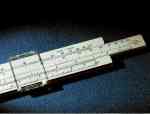At community colleges across the country, students are dropping out of school because they can’t pass their core English and math requirements. I’ve spent seven years tutoring college math students, and even taught the occasional algebra course. So while I don’t have an education degree or teaching certification — yet — I feel I can make some educated (ha!) comments about the common problems students face. And many of the same problems crop up all the time.
I’ll also make a separate page on my blog keeping an archive of these things. But here’s the first one:
Stop relying on your calculator for everything.
I realize that many of our students are non-traditional. That’s a term that we in the field use to refer to people who didn’t go straight from high school to college, but waited a few years instead. For some of our students, it’s been four decades since they’ve seen a classroom. It’s therefore not surprising when a student says they forgot their multiplication tables a long time ago. But I see a lot of students directly out of high school who can’t work out things like 5+8 or 7×9 without using their fingers – or a calculator.
Ah, calculators. I love calculators. Ever try to work out the cube root of 42 by hand? Yeah, me neither. But where math students get into trouble is when they buy into bogus arguments like, “I don’t need to memorize my multiplication facts / know how to work with fractions / learn how to do long division. In the real world, I’ll have a calculator.”Well, yes, you will. So given that you can always punch in “7 × 9 =” and read the answer on the display, why should you bother to memorize your basic math facts? Let me count the reasons:
- Having the answer memorized is faster.
- Calculators break down. Batteries die, sodas get spilled, gravity attacks.
- Calculators round everything. 2 divided by 7 is not 0.285714286, no matter what your calculator says.
- Everyone punches a number in wrong on occasion. Without the “number sense” that comes from mastery of basic arithmetic facts, there’s no way you’ll recognize a bad result when it happens. Imagine that you’re using your calculator to multiply 26.7 × 39.8, but you accidentally punch in 56.7 instead of 26.7 – an easy mistake to make. So the calculator pops up with 2256.66 as the product. A person with a developed number sense will say, “Waaaait a second: 26.7 × 39.8 is roughly 25 × 40, and if 25 × 4 is 100, then 25 × 40 is 1000. So I should be getting an answer around 1000, not over 2200.”
- There’s an even more important reason to have a developed number sense: when you get to algebra, you’ve got to be comfortable enough with numbers to have a feel for how they work together. If your teacher puts the expression (5 + 8)² + 7 × 9 on the board, and she simplifies that to 13² + 63, she expects you to know that 5 + 8 = 13 and 7 × 9 = 63. If you don’t, you’re going to be staring at the board, asking yourself, “Where did the 13 and 63 come from?” For that matter, let’s say you’re being taught to solve simple equations, like x + 9 = 17. When you solve that, you get x = 8… but if you can’t look at the equation and say, “Oh, yeah, 8 + 9 does make 17,” without thinking about it, then you’re not really getting it; you’re just trusting the magic. And math classes aren’t about magic, they’re about clear, logical thinking. Your goal is to de-magic things.
Fifty years ago, before inexpensive electronic calculators, people had other tools: slide rules and books of math tables. (I had an old-fashioned math teacher in high school who, for one unit, made us learn to do multiplication with a logarithm table! Bob Szorc, if you’re out there, thank you.) But slide rules and table books were different from modern electronic calculators in one critical way: they assumed you could do the simple stuff on your own. With a log table book, you can work out the cube root of 42, but you have to be able to divide by 3 on your own. In fact, the original meaning of the word “calculator” was “someone who does calculations.”
Now, with a handy Sharp or Casio or ti or hp, the game’s changed… in same ways for the better, in some ways not.So, my first piece of advice: memorize your basic math facts. Do whatever you need to do. Buy flash cards. Have a friend quiz you on them – in fact, work on improving your time. Rent the Schoolhouse Rock cartoons – they’re available on DVD. Most importantly, when you have to multiply 26.7 × 39.8, do it by hand first, and then check your answer on the calculator.
And the best thing about having a handle on the basics is that it’s a great confidence builder. Which leads into my next bit of advice for math students… next time.


Amen!